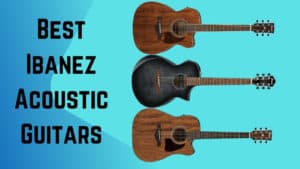Epiphone Pro vs. DR 100: Which is better for beginners?
Two different models from the same manufacturer often face each other off when you go hunting for an entry-level acoustic. Oftentimes, they have similar specs and pricing, making it hard to figure out which of them is the right acoustic guitar for you.
The Epiphone PRO 1 and DR 100 are textbook examples of this dilemma. Both of them are best-selling acoustic dreadnought guitars with similar specifications except for scale length, fret size, and neck wood. This makes it difficult for first-timers to decide which is the better choice.
Ideally, you would try them in a local store to see how the fit/feel matches your stature. Many times that is not an option due to our geographical location. Or, sometimes the local stores don't stock those models. This is especially true for small towns and neighborhoods.
No sweat. That’s why I have decided to write a comprehensive shootout between the PRO 1 and DR 100 – two Epiphone acoustics that have captured your attention. I have reviewed the DR 100 in my Best Epiphone Guitars 2021 post, you can check it out here.
So, without further ado, let’s see how they square up to each other so you can make an informed purchase and get full bang for your buck.
Table of Contents
Epiphone Pro 1 Acoustic Guitar Overview

The Epiphone PRO Series features the PRO 1, PRO 1 Plus, PRO-1 Ultra, and a nylon-string equivalent called the PRO-1 Classic (3/4 size). We’ll keep it simple and talk about the PRO-1 – the cheapest model. It is a no-frills dreadnought acoustic guitar made for students, children, and hobbyists.
Key Features:
- Select Spruce Top with Mahogany Body
- 24.72” scale-length
- Okume neck with 20 JumboPRO Frets
- GraphTech Nut and Saddle
- Granadillo Bridge
The body is a combination of select spruce (top) and mahogany (back and sides) with a slim-profile, C-shaped mahogany neck. The acoustic guitar has a 24.75” scale length with 20 jumbo frets. It is available in three color options: Vintage Sunburst, Ebony, and Natural.
Epiphone DR100 Guitar Overview
Epiphone DR-100 has been around for a while. It is a popular choice among students and beginners because of its modest price tag and its thick/full sound. It's among the bestselling dreadnought acoustics in the entry-level segment, and for all the right reasons.
Key Features:
- Select Spruce Top with Mahogany Body
- 25.5” scale-length
- Mahogany neck with 20 Medium Jumbo Frets
- GraphTech Nut and Saddle
- Premium Die-Cast Tuners
The full-sized dreadnought sports a select Spruce top with layered mahogany back and sides. It features a Slim Taper C-profile neck with a 25.5 inch scale and 20 Medium Jumbo frets. The DR 100 is also available in three color options: Vintage Sunburst, Ebony, and Natural.
Side-by-Side Comparison: Epiphone DR100 vs Epiphone Pro 1
Pro 1 and DR 100 are entry-level acoustic guitars by Epiphone that cost less than $150. Both models have done well in this segment due to their quality, pricing, and the brand name of Epiphone to back them up.
They carry the classic shape with a non-cutaway design and layered Spruce tops. Many features are common to both but there are notable dissimilarities. In this section, we look at what differentiates them in terms of tone, construction, hardware, and value for money.
Build Quality
Both guitars score the same points in terms of build quality and craftsmanship. Both models are balanced and comfortable as you played them while sitting or standing. They are made by Epiphone, so there is no reason to believe that a particular model has better QA than the other.
PRO 1 has better action and fretwork. The PROJumbo Frets are spacious and easy to navigate. On the other hand, the mahogany neck and dovetail neck joint of DR 100 are superior to the “Deluxe” tuning machines and Glued-in joint of the PRO 1.
In a nutshell, I would say that the Epiphone PRO 1 is cheaper, lighter, and relatively petite compared to the Epiphone DR-100. We will discuss how that makes it more beginner-friendly when we talk about playability.
Hardware & Components
The PRO 1 ships with awfully light strings (9 – 47). Epiphone probably chose the Ultra-light set to make the acoustic easy to play for beginners. Many guitar players will find it way too light. Plus, it takes away from the sustain and lows, which is a poor way to judge the tone. The guitar sounds better with 11 gauge strings.
Conversely, the Epiphone DR 100 ships with 13 - 56 strings, which are the driving force behind its lush, and full-bodied tone – the kind you would expect from a dreadnought guitar. Other than that, both models have similar hardware but the die-cast tuners of DR 100 are decidedly better.
Playability:
The low action on the PRO 1 is helpful for beginners. It will make it easier to fret chords and practice your scales. Now combine that with the slim and fast neck and you've got a really easy-to-play instrument with the PRO 1. However, this aspect is only obliging for students. You will sooner or later reach a point when this much of a difference in dimensions doesn’t matter.
DR 100 has the standard 25.5 inch scale length compared to the 24.72" scale length of the Pro 1. The numerical values may not seem far apart, but it is a significant effect in terms of playability. In general, the PRO jumbo frets, high string spacing, and smaller body of the PRO 1 provide more comfort and ease for beginners.
Plus, young adults, guitar players with small hands (or short stature) will find the PRO-1 easier to maneuver and handle. Bear in mind that the advantages of the PRO-1 only come into play for children and beginners. To a regular-sized person, DR 100’s standard dimensions do not pose any additional challenges. It is just as playable as any regular dreadnought guitar.
Tone:
Epiphone PRO 1 may have better playability, but DR 100 is a clear winner when it comes to tone. PRO 1 isn't bad per se. The sound is bright (with a little top-end zing), and the intonation and fretwork are good for the price. But it doesn’t sound nearly as deep or rich as the DR 100. The shorter scale and small(er) body render a sound that is not as thick while sounding chords.
Keep in mind that both of them are entry-level instruments. Neither of them is marketed as an intstrument for stage or studio use. Moreover, because acoustic guitars rely on wood (layered or otherwise), there will be some variance in different models of the same series. But in a head-to-head shootout, DR 100 sounds more deep and well-balanced compared to the Epiphone Pro 1.
Price and Value:
Epiphone PRO 1 is more expensive than the DR 100, though not by much. The PRO costs roughly twenty dollars less, but the price difference is compensated by better hardware and the mahogany neck of the DR 100.
The components, hardware, and tone of the DR-100 are superior (to my ears). The key selling point of the PRO 1 is the beginner-friendly design, which is better suited to kids and students. They both offer good value for money – on par if not better than other guitars in this segment.
VERDICT: Epiphone DR 100 vs. PRO 1
My opinion is new students, young adults, and people with small hands will benefit from choosing the Epiphone PRO-1 1 over the Epiphone Songmaker DR 100. The shorter scale, jumbo frets, and relatively slim body will ease the process of learning chords and scales. For others, the DR 100 is still my top pick among entry-level acoustic dreadnought guitars.
It has better hardware, fuller sound, and sounds better compared to the PRO 1. In that sense, the DR 100 is not just a ‘beginner guitar.’ It’s an equally viable choice for experienced guitar players who want an at-hand instrument for couch practice or electric guitarists who need a dreadnought to noodle around. So if dimensions and ease-of-use are not key considerations, DR 100 gives you more value for money.
In Conclusion:
It’s good to do your research before you buy a guitar, even if it is an inexpensive instrument. I hope this shootout has highlighted the difference between the two models. Based on these differences, you can figure out which one may work out best for your needs.
Manufacturers don't invest too much time in setting up entry-level guitars. My recommendation is to replace the strings, file the nut/saddle, and get a proper setup from a technician. It will instantly improve the value and tone of the instrument, regardless of which model you choose.
We have a ton of acoustic guitar reviews if you are looking for other options. Feel free to check them out. If you are still confused, your best bet is to visit your nearest store and let your ears be the judge. Sometimes a guitar just ‘feels right’ and eliminates the need for logical inferences. After all, the heart wants what it wants. As always, happy hunting!


